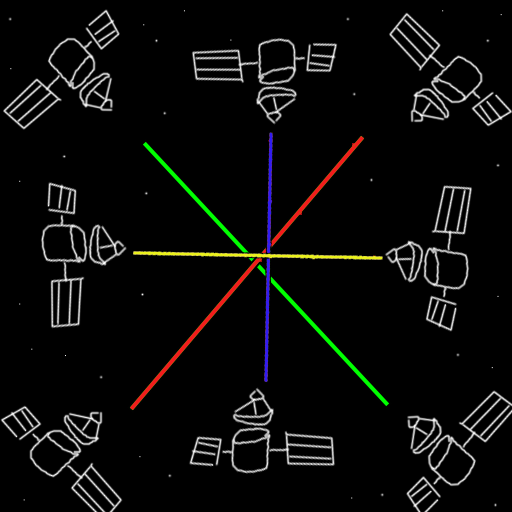Probe Swarms
Chapter 3 of Scribes’ Descent says that Mallory’s mom writes code to help probes find another wormhole, but the book gives no further detail about it. If you’ve been wondering what programming code has to do with space probes, you’ve come to the right place!
To search new areas of space for an undiscovered wormhole, the Facility has launched several probe swarms. Each swarm consists of eight probes, arranged into four pairs where each probe lies opposite its partner, like this:
 |
One probe in a pair tight beams a signal to the probe across from it. If nothing blocks that beam, the signal will be detected by its counterpart. But if the beam isn’t detected, one of two things has occurred: some object got in the way (such as a meteor) OR the beam passed through a wormhole, which redirects the signal to a distant galaxy:
 |
In the image above, 3 of the 4 signals were intercepted by a wormhole. Even if only 1 signal is intercepted, the whole swarm will stop and investigate the area in more detail.
Why is code needed?
Probe swarms venture quite far from Daishon. So far that it takes light several minutes to travel to the astronomy lab on the Facility. Probes often need to make decisions within seconds. Is it about to collide with an asteroid? The probe must be able to dodge it on its own guidance–without manual control signals from an astronomer. By the time such manual signals reach the probe from Daishon, the probe would be smashed into scrap.
Mallory’s mom, Henel, writes AI code that probes use to make these autonomous decisions.
Probes also need to recognize interesting objects in space that warrant further investigation. They use tools like gas analyzers. If the probe ventures into a pocket of gas where gas isn’t expected, that could mean part of a nebula has floated into a wormhole. (The next time you cut wind, just tell your neighbors it was a passing nebula  )
)
Probes also use motion sensors to detect changes in light. A wormhole opening is shaped like a flat disk. This blocks light from “local” stars behind it and casts light from “remote” stars that lie beyond the wormhole. That’s why probes look for sudden changes in brightness. Sometimes these changes happen for other reasons, though, like when a moon passes between a star and the probe, so independent checks by other probe swarms may be needed.
Each probe swarm has a designated messenger that sends noteworthy findings back to Facility astronomers. It may also report the results of routine self-diagnostics checks. Scientists like Henel transmit software updates to the swarm’s messenger probe, which goes on to relay that update to the other probes in the swarm.
Repairs
Because they eventually get damaged by space debris, probes carry their own spare parts and onboard robots to repair themselves. These robots rely on AI code, also written by Henel, to assess the damage, decide which parts are needed, and guide the robotic arms to swap out damaged parts with spares. If the part supply gets used up or any part of the diagnostic system is damaged, other probes in the swarm may dock with that probe to fix it. If this isn’t possible, the Facility astronomers will launch a replacement probe.
Orbital Capture
Every so often, a probe swarm may blunder close to a massive body like a moon or planet and fall into its orbit. At the very least, this can divert the swarm from its intended course. At worst, the swarm can fall from orbit and crash land on that body. Ordinarily, navigational code steers probe swarms away from bodies like these, unless there is reason to suspect a wormhole might lie in its orbit. But sometimes swarms end up captured in an unwanted orbit anyway. If that happens, AI code will perform orbital calculations and apply just enough thrust at the right time to escape from orbit in the intended direction.
Unfinished Project
Right before Henel Leighyan was lost in the Feldencourt quake, the Facility had released the new namiron neutrino comm system. This tech allows call signals to pass through virtually all matter, including stars, moons, and planets. Henel was about to redesign the probe comms logic to use the new namiron system. But then the quake happened, swallowing up the lead programmer for the project and greatly delaying this changeover.
And that’s about it. I didn’t explain how the probes are powered or how they explore the other side of wormholes when they’re found, but I could cover that in a later newsletter.
Have questions about wormhole detection and probe swarms I didn’t answer here? Reply and let me know!
Writing update: So far, I’ve totally rewritten the first four chapters of Scribes Emerge (Scribes Series book 3). I’m shooting for 1,000 words a day, whether that takes the form of actual draft or brainstorming notes.
See you next month,
Dylan West
